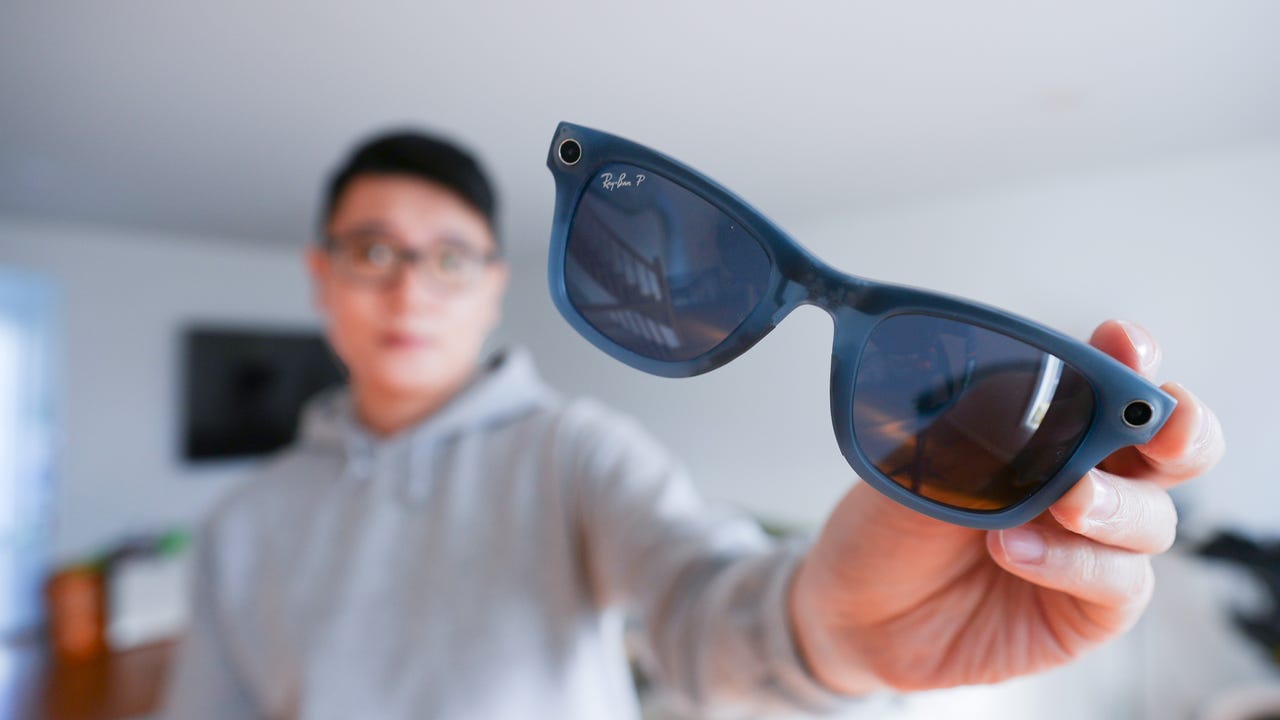June Wan/ZDNET
For a company that literally rebranded itself during its pursuit of creating a virtual society, Meta’s $299 smart glasses pitch is more straightforward (and relatable) than it seems.
Also: Meta’s $500 Quest 3 is the mainstream VR headset I’ve been waiting for, and it delivers
The new smart glasses, made in partnership with Ray-Ban, are exactly that: premium glasses that can do “smart” things. They’re as stylish and iconic as every other pair of Ray-Ban. They can also capture photos and videos, play music and podcasts when paired to your phone, and have a built-in Meta AI to answer your most curious questions.
For many, including myself, that makes the Meta Ray-Ban a seamless lifestyle fit — one that is less drastic than, say, Meta’s other new on-your-face gadget, the Quest 3. And after spending a weekend with the latest wearable, I’m preparing to switch to the spectacles full-time. Here’s why.
I wear prescription glasses on a daily basis, a pair from Ray-Ban that looks very similar to Meta’s, but minus all the tech smarts. That made my transition to the Ray-Ban glasses one that was curiously familiar. Folks who normally wear sunglasses may and should expect to feel the same way.
Also: These new AR smartglasses bet big on audio and ChatGPT and start at $199
Even with the cameras, speakers, and various modules tucked beneath the frame — all of which are made visible thanks to a new transparent finish that Meta is offering — the smart glasses are surprisingly lightweight, and fatigue only kicks in the first time you put them on.
The Meta Ray-Ban Smart Glasses (left) next to my standard Ray-Ban glasses (right).
June Wan/ZDNET
Other key improvements with the new Ray-Ban smart glasses include a 12-megapixel ultra-wide camera that’s capable of capturing sharper photos at 3024 x 4032 pixels and 1080p videos at 1440 x 1920 resolution. Note that both formats are scaled for portrait capturing, as the ideal use case for the glasses is vertical content sharing on Meta’s social platforms, such as Facebook and Instagram. That content-sharing capability includes live streaming, which you can now start up with a few taps on the wearable.
Also: Apple ‘smart glasses’ could be an iPhone accessory and cheaper than Vision Pro, suggests new patent
When you’re on the live-streaming Meta platform of choice, a camera button magically appears for you to switch from your phone’s camera to your smart glasses. While the new capability is more geared towards influencers and content creators, I’ve found the general focus on vertical video beneficial for when I’m recording hands-on product demos and other short-form content for ZDNET’s social pages.
June Wan/ZDNET
I typically rely on an Insta360 Go 3 to record POV (point-of-view) footage when I’m at product briefings and trade shows, so being able to capture footage simply by looking around is especially beneficial for me. I’ve also found the smart glasses practical when I’m driving and want to record a scenic view or need a second camera (on top of my dashcam) in the case of an accident.
Video recording on the Meta Ray-Ban glasses isn’t perfect, though. The 12MP camera doesn’t handle dynamic range as flawlessly as a smartphone or action camera — the sky tends to get blown out, as shown in the video demo above — and the aggressive video stabilization means there’s the occasional stutter when the software doesn’t stitch the shakiness properly. Still, the glasses’ camera is reliable enough to capture the general essence of moments, which is what this whole thing is about, right?
To assist with the focus on video, Meta equipped the Ray-Ban glasses with five microphones, one of which is cleverly tucked in the nose bridge for the most optimal voice recording. The other mics are scattered across the front and sides of the Ray-Ban and can now be used to record 360 audio. The new feature works great, but I find it gimmicky as every other audio format I listen to plays in stereo.
Also: This thumb-sized camera is my new ‘must-have’ for traveling
It’s worth pointing out that for the sake of people’s privacy, Meta made the blinking animation of the LED indicator a lot more noticeable when the glasses are recording. The glasses also won’t record at all if they detect anything covering the LED indicator, which everyone can appreciate.
The side of the glasses serves as a gesture touchpad for music, volume, and Meta AI controls.
June Wan/ZDNET
Besides the photo and video-capturing aspect, the new Ray-Ban smart glasses are just decent-sounding Bluetooth headphones. They sound better than the Stories I tested two years ago, but not by much. Meta tells me that the one key area of improvement is a new directional output that greatly reduces sound leakage. But I can’t lie when I say I still felt guilty listening at higher volumes in public. The grim stares made it clear that the sound isolation wasn’t perfect.
Also: You can demo Meta’s AI-powered multilingual speech and text translator. Here’s how
What I’m sure of is that those around me probably couldn’t hear Meta AI, the glasses’ built-in chatbot, whenever it responded to my queries, and that’s because even I could barely make out what the voice assistant was saying at times — and there’s no way to adjust the volume of it.
Meta AI is still young, and its inconsistency with answering questions proves it. Conversing with Meta AI is much like the early stages with ChatGPT. You’re encouraged to ask more descriptive questions, hold longer conversations, and even follow up at times, but I’m not so sure if the AI is capable of going into more details yet. For example, when asking for a dinner recipe, the “elaborated” answer that the chatbot provided was no longer than the “brief” answer; the only difference was adding “my preference of seasoning.”
June Wan/ZDNET
Before I wrap, I’d like to give a nod to the new charging/carrying case for the smart glasses. It still serves as a wireless charger when the glasses are slotted in, but it’s also significantly slimmer than the previous version, with a leather booklet style instead of the hard-cushioned, snap-on capsule. Meta says it’s 32% lighter than the last model, which I believe, and gives the glasses eight full charges or 32 hours of additional battery life.
ZDNET’s buying advice
The new Meta Ray-Ban Smart Glasses feel more like traditional eyewear and less like the glasshole-wearing ones from a decade ago. That’s a win in my book, because, with the Ray-Ban smart glasses, Meta isn’t trying to impress tech geeks like me with out-of-world experiences (though it somehow did, thanks to the practicality of it).
Also: Buying an Apple Watch? How to pick the best one for you
Instead, the Meta glasses focus on the essentials like Bluetooth music listening, AI voice assistance, hands-free photo and video capturing, and more; features that should entice a more mainstream audience, preferably folks who have already become accustomed to paying $200 and more for prescriptions and shades.
If you’re considering buying a pair, I’d recommend visiting a local Ray-Ban or Best Buy store and testing the glasses for yourself. You may end up liking them as much as I do.



